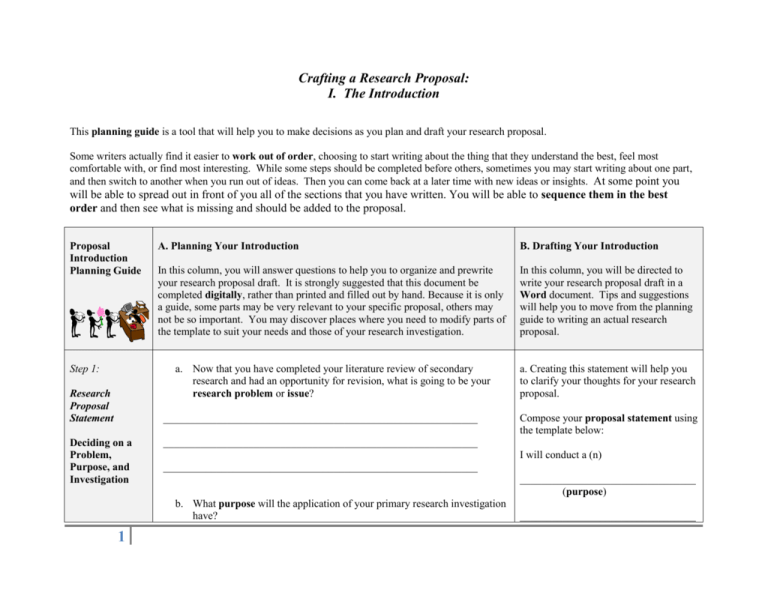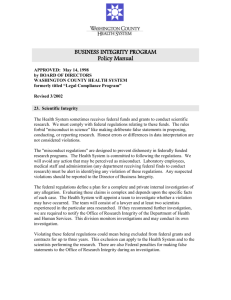Crafting a Research Proposal:The Introduction
advertisement

Crafting a Research Proposal: I. The Introduction This planning guide is a tool that will help you to make decisions as you plan and draft your research proposal. Some writers actually find it easier to work out of order, choosing to start writing about the thing that they understand the best, feel most comfortable with, or find most interesting. While some steps should be completed before others, sometimes you may start writing about one part, and then switch to another when you run out of ideas. Then you can come back at a later time with new ideas or insights. At some point you will be able to spread out in front of you all of the sections that you have written. You will be able to sequence them in the best order and then see what is missing and should be added to the proposal. Proposal Introduction Planning Guide Step 1: Research Proposal Statement A. Planning Your Introduction B. Drafting Your Introduction In this column, you will answer questions to help you to organize and prewrite your research proposal draft. It is strongly suggested that this document be completed digitally, rather than printed and filled out by hand. Because it is only a guide, some parts may be very relevant to your specific proposal, others may not be so important. You may discover places where you need to modify parts of the template to suit your needs and those of your research investigation. In this column, you will be directed to write your research proposal draft in a Word document. Tips and suggestions will help you to move from the planning guide to writing an actual research proposal. a. Now that you have completed your literature review of secondary research and had an opportunity for revision, what is going to be your research problem or issue? a. Creating this statement will help you to clarify your thoughts for your research proposal. ___________________________________________________________ Deciding on a Problem, Purpose, and Investigation ___________________________________________________________ I will conduct a (n) ___________________________________________________________ _________________________________ (purpose) b. What purpose will the application of your primary research investigation have? 1 Compose your proposal statement using the template below: _________________________________ (investigation) ____ basic ____ applied ____ practical in order to c. What is the primary method of investigation that you will use? _____ experiment _____ non-experiment _________________________________ _________________________________ (restatement of problem or issue) Step 2: d. Title Page: My title will be: Title Page _______________________________________________________________ Creating My Title _______________________________________________________________ b. Create a Word document entitled “Research Proposal Draft.” In that document, create your title page, using the appropriate format based on your proposed research investigation. _______________________________________________________________. e. Based on the type of research investigation that I will be doing, I will follow the following style guide in formatting my title page: _____ APA Step 3: Introduction Drafting My Introduction ______ MLA ______ Chicago ______ CSE As you answer these questions, consider ways in which some answers could be combined together into more developed paragraphs because their ideas and explanations are related. f. Clear Statement of the Problem: What is your problem or issue? _________________________________________________________________ c. Open your Word document entitled “Research Proposal Draft.” Using the same document, begin to compose your proposal on page two, the page after your title page. Follow the appropriate format for your area of investigation and consult with the sample research proposals that you have already studied. _________________________________________________________________ _________________________________________________________________. 2 As you begin this writing process, here are some basic things to remember: Write in past tense when you describe what you did do; write in future tense when you describe what you will do. The most important thing to remember is that each element of the introduction of a research proposal does NOT need to be its own separate heading and section. Use the sample proposals for ideas on how different elements can be combined together in written explanations. c. Always structure your work in advance and know what you want to say before trying to write it. I will do the following to help me to reach this goal: Every sentence must contain one main idea only. a. Don’t use words when you are not certain of their meaning or difficult words to impress your reader. Each sentence must follow logically from the one before. A well written text is a "chain of ideas.” Use transitional words, phrases, and even paragraphs to help your ideas connect. While writing, keep your reader's needs in mind. Provide a "map" of g. Purpose of the Study: What are the goals and objectives of your research? Be sure to consider whether you have decided to do a basic, applied, or practical investigation when deciding your goals and objectives. While you may only have one or two major goals, each goal may require you to set several more concrete and measurable objectives. Goals Objectives One goal of this study is to... I will do the following to help me to reach this goal: a. b. Another goal of this study is to... b. c. A third goal of this study is to... I will use the following to help me to reach this goal: a. b. 3 your document so that your reader knows what to expect; place "verbal signposts" in your text to label what is being described. Use clear headings and subheadings for sections and consistent formatting in fonts and styles. c. h. Definitions: What are some key words or concepts that someone needs to know to understand my descriptions and explanations in this proposal? How can I explain them so that most people could understand the meanings? Should I explain with words or in some other way? Term 4 Definition Prepare a list of key words that are important to your research and then your writing should use this set of key words throughout. Don’t alternate or substitute words to mean the same thing. Always stay with the same phrase or technical term. It will be very clear to the reader to what you exactly are referring. i. Significance of the Investigation: Why is your study important? To whom is it important? What benefit(s) will occur if your study is done? _________________________________________________________________ _________________________________________________________________ _________________________________________________________________ _________________________________________________________________ _________________________________________________________________ _________________________________________________________________ _________________________________________________________________ _________________________________________________________________. j. Questions or Hypothesis: What questions will you investigate through your investigation? OR What hypothesis will you test? _________________________________________________________________ _________________________________________________________________ _________________________________________________________________ 5 _________________________________________________________________ _________________________________________________________________ _________________________________________________________________. Step 3: k. Reflection: Review of Literature Embedding My Literature Review Now that you have begun the process of writing about your own primary investigation, are there things that you would revise, change, or add to your literature review? How will you make it “fit in” with the rest of the research proposal? Answer these questions in three or more paragraphs in your Reflection Journal. Step 4: l. Revision Revising My Proposal Draft Consider how the following writers describe revision: 6 d. Copy-Paste your literature review into the body of your research proposal. It always is in the introduction section, and usually it comes in sequence before your research questions or hypothesis; however, its placement will be decided by you based on how you have organized the other elements of your research proposal. It is not combined with other elements of the proposal; keep it as its own section. Review sample proposals to see what other researchers have done. e. Self-revise your introduction rough draft using the Revision Checklist. Make any changes to your draft. "I rewrite a great deal. I'm always fiddling, always changing something. I'll write a few words--then I'll change them. I add. I subtract. I work and fiddle and keep working and fiddling, and I only stop at the deadline." (Ellen Goodman) f. Save your Word file to the Wiki so that others may read it and make comments and suggestions, using the revision checklist. "Revision is very important to me. I just can't abide some things that I write. I look at them the next day and they're terrible. They don't make sense, or they're awkward, or they're not to the point--so I have to revise, cut, shape. Sometimes I throw the whole thing away and start from scratch." g. Throughout the writing process, and especially during this step when you have the advice and suggestions of others, revise your paper in order to continually improve it. Using a Word (William Kennedy) Consider revision the same as renovation. Your text needs to be shifted around, added to, or even deleted. Changes should occur in your draft. Step 5: m. Editing Editing My Proposal Introduction You are now ready to edit your revised draft of our research paper. Editing is different from revision; when editing, the writer or peer editor carefully examines a paper to see that it contains no errors of grammar, spelling, or punctuation. file for your draft makes it easy to copy, paste, insert, move, and cut chunks of text as you revise your paper. h.Use the Edit and Polish Checklist to help you to make final edits to your introduction. This is a good place to remind you, too, that the stages of the writing process overlap, and at times we may have to back up and repeat a stage. The process is broken down for you, however, so you don’t have to focus on all stages at the same time. In fact, trying to do too much at one time is likely to create frustration, not make the writing go faster or easier. Step 6: n. Next Step: Approach to Research Design Now you will need to make some decisions about the type of approach that best describes your anticipated research design. Although your ideas and understandings may continue to change as you plan, draft, and write your research project, and may even continue to evolve during the your research investigation, you have to start your planning somewhere. You are now prepared when the time comes to start II. Crafting a Research Proposal: Approach to Research Design. 7 You are done writing for now. The next planning guide will be used as a tool to guide you through the planning and organizing of your methodology portion of your research proposal.






